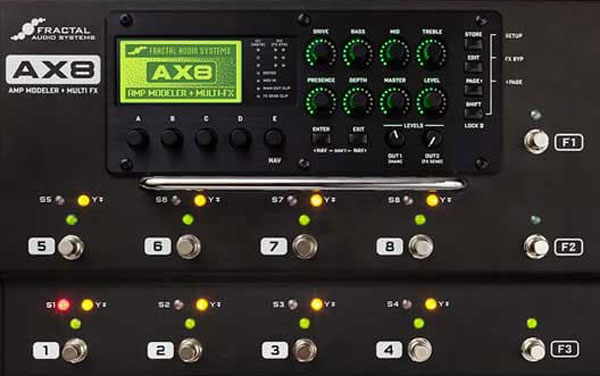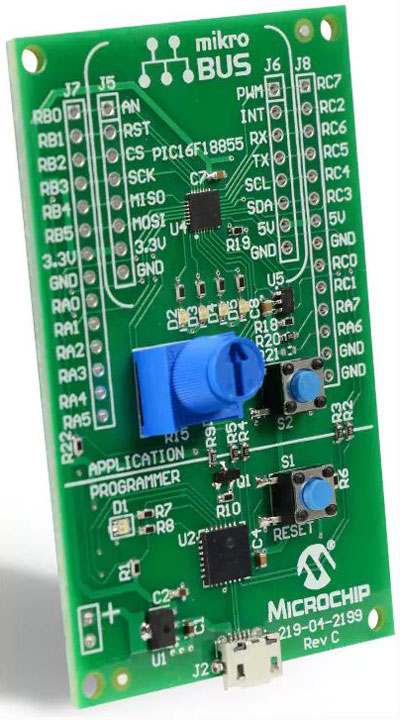Xpress your designs with the Microchip MPLAB Xpress dev board
Paul Golata, Mouser, explains how you can express your designs with the Microchip MPLAB Xpress dev board.
Give me a Les Paul and turn the amplifier up to ten and let’s get busy. My amplifier of choice is a clone of a guitar amplifier that costs upwards of $40,000 since it is so rare and sought after—Ken Fischer’s Trainwreck Express amplifier. Trainwreck amplifiers, and in particular the Express model, are known to be fast and dynamic.
I have recently incorporated the Fractal Audio AX8 as an all-in-one Amp Modeler + Multi-Effects Pedalboard Processor in lieu of my traditional amplifier. And as a base rock-n-roll patch, I have programmed the Trainwreck Express.
 Figure 1: Fractal Audio AX8, Amp Modeler + Multi-Effects Pedalboard Processor. Image courtesy fractalaudio.com
Figure 1: Fractal Audio AX8, Amp Modeler + Multi-Effects Pedalboard Processor. Image courtesy fractalaudio.com
Express is a simple word; it is based on the Latin pressare (to press) and ex (out), meaning: to press out. In a modern context, it can be used as an action verb to demonstrate one’s ideas. When used as an adjective it denotes high-speed, rapidity, swiftness, and quickness.
As an engineer, I still carry over the attitude of ROCK into my ability to design. I want my designs to be fast and dynamic. In the same way that I want my mind and fingers to find their expression through the sounds of my amplifier, I want my electronic designs to quickly and swiftly capture my thoughts and find expression right from the start, so that I can proceed.
I have known and used Microchip for many years. I have been most familiar with them through their family of PIC Microcontrollers (MCUs), particularly their 8-bit family, due to their simplicity in getting things going in a design. Microchip is recognised for their long-standing ease in helping engineers get designs started by following the 'keep it simple stupid' (KISS) principle.
The design world often over complicates itself by often assuming that a 32-bit MCU is needed at the start, so sometimes it just feels most comfortable to rely on the simplicity and long-term stability and reputation of PIC MCU platform design.
For a while now, Microchip’s development tool, which operates upon its personal computer software application programme for use with its PIC MCUs, has been the MPLAB-X Integrated Design Environment (IDE). The IDE supports software realities, such as code editing, code build, compiling, debugging, and graphical user interface (GUI). MPLAB-X IDE is a unique and fully comprehensive place for engineers to develop code that is based within an open-source NetBeans programming that provides module software components.
 Figure 3: Microchip MPLAB Xpress IDE. Courtesy Microchip.com
Figure 3: Microchip MPLAB Xpress IDE. Courtesy Microchip.com
Microchip has now gone one step further in making the designer’s life easier with the ability to express oneself faster. They have recently introduced the MPLAB Xpress, which moves a full-featured, albeit an abbreviated version, of MPLAB-X IDE from the personal computer to storage and operation from an online cloud. Thus, an engineer can create their design entirely from a web browser, which means no pesky updates and a less cluttered personal hard drive. It does all this while maintaining many of the features that mae MPLAB-X IDE so valuable to work with.
It’s so much simpler and quicker because it does not require the downloading, driver installation and subsequent configuring that is so ubiquitous with PC-based IDE platforms, so when I found out, naturally I had to immediately try it. It is truly Xpress, no more waiting for downloads.
In addition to not having to wait for it have to be downloaded and then taking up space and residing on my computer, it is now easy to access anywhere. I love this! It’s cloud-based design allows me to design and perform simulations without a board, although a development board is readily available. It also offers a library of existing projects that one can start on.
One of the coolest things that happens in electronics is that everything invariably gets cheaper; Moore’s Law helping my wallet. For the price of a lunch I can now buy the new Microchip MPLAB Xpress Board.
 Figure 4: Microchip MPLAB Xpress Board
Figure 4: Microchip MPLAB Xpress Board
Where was this thing when I was in college?
On the board is a PIC16F18855 8-bit MCU (with 14KB Flash, 1KB RAM, 256B EE, and 10-bit analog-to-digital converter with computation). This MCU is indicative of the PIC series and a fine standard that is both sufficient to get started with and to grasp and learn the simplicity inherent in the breadth of the entire PIC family.
The board provides breakout headers that allow hardware engineers the ability to get to the MCU’s pins. Additional capabilities are augmented by it being provisioned with a header to accommodate add-on products by MikroElektronika, a renowned producer of a wide range of development tools for various microcontroller families including Microchip’s PIC, dsPUC30/33. PIC24 and PUC32—that provides the potential of greater than one hundred different hardware add-ons.
Software programmers are allowed to access Microchip’s compilers in the cloud and take advantage of previous Microchip design examples. The board provides a Universal Serial Bus (USB) to interface with the MCU’s memory so that no external hardware is needed, the USB cable is even provided.
Check out both Microchip MPLAB Xpress and the Microchip MPLAB Xpress Development Board.
Get your designs done quickly and easily.
Xpress your designs to the world and amplify your application development to a volume of ten.
For more information, click here.










